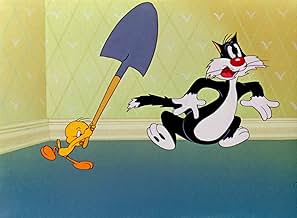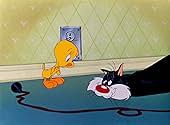IMDb-BEWERTUNG
7,1/10
1667
IHRE BEWERTUNG
Thomas die Katze findet Tweety im Schnee und wärmt sich an einem Zigarettenstummel. Thomas' Besitzerin rettet den kleinen gelben Vogel, bevor ihre Katze ihn fressen kann, aber Thomas gibt ni... Alles lesenThomas die Katze findet Tweety im Schnee und wärmt sich an einem Zigarettenstummel. Thomas' Besitzerin rettet den kleinen gelben Vogel, bevor ihre Katze ihn fressen kann, aber Thomas gibt nicht auf.Thomas die Katze findet Tweety im Schnee und wärmt sich an einem Zigarettenstummel. Thomas' Besitzerin rettet den kleinen gelben Vogel, bevor ihre Katze ihn fressen kann, aber Thomas gibt nicht auf.
- Regie
- Drehbuch
- Hauptbesetzung
- 1 Oscar gewonnen
- 1 wins total
Bea Benaderet
- Sylvester's Mistress
- (Synchronisation)
- (Nicht genannt)
Empfohlene Bewertungen
If you watch a number of these Tweety and Sylvester cartoons you'll notice the two stars with different owners. "Granny" is the usual owner of Tweetie, but not always. Here, in this cartoon we see a woman who already owns Sylvester, taking in Tweetie whom she thinks is an abandoned bird. She calls our cat here "Thomas," too, and she's a nasty woman. She would be reported for animal abuse, in this day and age, as she constantly beats Sylvester with a broom.
This gets off to a good start as Tweetie is outside freezing in the show. Sylvester is hidden inside a snow man waiting for the right time. That comes along quickly and Sylvester jumps out, puts on his snow shoes and starts stalking the little bird. When he pounces, he grabs the little heater that Tweety was using to get warm, instead of the bird. A second try succeeds, but the cat's owner comes out and demands to know what he's hiding inside his paws. She winds up taking in the bird.
The rest of the cartoon is the standard material of the cat trying to catch the bird who is in his cage way up in the ceiling.
This was passable but I didn't care for the beatings "Thomas" took from the owner. I understand this was the first pairing of the two main characters, so it explains why we see different names and different owners. I'm glad "Granny" took over from this woman and Sylvester didn't have to hang around this house for too long.
This gets off to a good start as Tweetie is outside freezing in the show. Sylvester is hidden inside a snow man waiting for the right time. That comes along quickly and Sylvester jumps out, puts on his snow shoes and starts stalking the little bird. When he pounces, he grabs the little heater that Tweety was using to get warm, instead of the bird. A second try succeeds, but the cat's owner comes out and demands to know what he's hiding inside his paws. She winds up taking in the bird.
The rest of the cartoon is the standard material of the cat trying to catch the bird who is in his cage way up in the ceiling.
This was passable but I didn't care for the beatings "Thomas" took from the owner. I understand this was the first pairing of the two main characters, so it explains why we see different names and different owners. I'm glad "Granny" took over from this woman and Sylvester didn't have to hang around this house for too long.
In the first pairing of Sylvester and Tweety, the former comes up with another series of schemes to catch the latter, always failing miserably. One thing that raises my eyebrows in "Tweetie Pie" is that Sylvester is for some reason called Thomas (as identified by his stricter-than-strict mistress). What gives? Oh well, it's still a great cartoon. I can see why it won an Academy Award. The winter setting also gives it an interesting spin. But even if it didn't have that, it would still really be something; how could it not be, with Mel Blanc and Bea Benaderet doing the voices? A formidable cartoon classic in every way, shape and form.
I didn't like "Tweety Pie". He was a nasty and manipulative little critter who used all his butter-wouldn't-melt tactics to thwart the perfectly reasonable efforts of "Thomas" to do what cats do. Eat him! This time, it's a very snowy garden that finds these two "playing", but as ever it's their owner who saves the feathers! She's determined that her two favourite pets are going to learn to play nice - but what chance, eh? Tom constructs ever elaborate plans to get the bird from it's cage but is consistently outwitted, usually quite painfully, but his scrawny nemesis. Why did he bother though? There's no meat on the thing, anyway! This is good fun with loads of action, a few quite fun contraptions used and by the end of this, I hated that bird even more!
The first short to pair Sylvester & Tweety was also the first short to win an Oscar for Warner Bros, breaking the streak MGM had going thanks to Tom & Jerry. Which is interesting because, in some ways, the Sylvester & Tweety series was very similar to Tom & Jerry. At least in terms of the basic structure of a cat chasing after a cute little critter. Also, the cat being named Thomas and the human woman who scolds the cat and hits him with a broom are other similarities in this first entry. Obviously there's much more to both series that separates them but there seemed to be something about this premise they both had in common that pleased Oscar voters back then as Tom & Jerry won a bunch of them and Sylvester & Tweety won a couple.
The story here is pretty basic. Sylvester (called Thomas here) catches Tweety outside in the snow. But before he can eat the bird, his owner catches him and brings adorable little Tweety inside. This doesn't stop the cat, who tries repeatedly to get at the bird with comical results. Tweety is much more aggressive (and Jerry-like) in defending himself against Sylvester in this first short. This is a good start to a series that would get much better once Sylvester developed his own personality and Tweety's was fleshed out some more. As it is, it's a funny short with nice animation, music, and voicework. I'm not sure it deserved the Oscar win but the Academy probably wanted to give a win to someone besides MGM or Disney that year and WB's Looney Tunes were screwed out of wins many other times.
The story here is pretty basic. Sylvester (called Thomas here) catches Tweety outside in the snow. But before he can eat the bird, his owner catches him and brings adorable little Tweety inside. This doesn't stop the cat, who tries repeatedly to get at the bird with comical results. Tweety is much more aggressive (and Jerry-like) in defending himself against Sylvester in this first short. This is a good start to a series that would get much better once Sylvester developed his own personality and Tweety's was fleshed out some more. As it is, it's a funny short with nice animation, music, and voicework. I'm not sure it deserved the Oscar win but the Academy probably wanted to give a win to someone besides MGM or Disney that year and WB's Looney Tunes were screwed out of wins many other times.
There are better Looney Tunes cartoons than the Sylvester and Tweety series but the series is still entertaining and nice to watch. Sylvester and Tweety are not among Looney Tunes' greatest duos, but at least their duo makes sense and doesn't feel odd(unlike Daffy and Speedy). Tweetie Pie signals their debut together- having been seen before solo- and it is a great one and one of their better cartoons. The cruelty of Sylvester/Thomas' owner is a turn-off point, the one character here who you dislike from the get go, but that's a personal nit-pick above all else. The animation is vibrant and detailed and with plenty of bounce, both Tweety and Thomas/Sylvester well and recognisably drawn and Thomas/Sylvester's facial expressions are expressively done. Carl Stalling's music not only is orchestrated beautifully but rhythmically it bursts with character and it gives great energy to the action. It's not just it sounding nice and that it's action-enhancing but also how well it accompanies the gestures and expressions of the characters and even the sound effects too. The dialogue is sharp and the gags while not surprising are made funny, in some instances hilarious(especially the one with Thomas/Sylvester trying to fly up to the cage via an electric fan), by the interactions between the duo and Thomas/Sylvester's facial expressions. Which like with Wile E. Coyote induces some of the laughs on their own, I don't think the fireplace gag would have worked quite so well without his reaction to that he was burning. Tweetie Pie is violent but actually not in a sadistic or bizarre way that it churns the stomach like the Gene Deitch Tom and Jerry cartoons did. Tweety has the cute- but not too sickly sweet- persona that he is now famous for but he also has shades of the anarchic personality that was given to him in the Bob Clampett outings. But Thomas/Sylvester makes the biggest impression, not just because he has the funniest moments but you also root for him, and this is in general not just here. He may have a different name and be fatter but the voice and the catchphrase are unmistakable. The two work great together and as aforementioned at the beginning of the review their chemistry makes sense, plus as usual Mel Blanc voices superbly. All in all, a great debut for this bird and mouse duo, one of their best if not their very best. 9/10 Bethany Cox
Wusstest du schon
- Wissenswertes"Tweetie Pie" was the first cartoon to have its characters Sylvester and Tweety appear together (note: each of those characters had appeared in cartoons originally released before this one).
- PatzerThe distance between the bars on Tweety's cage keeps changing every time Sylvester grabs the cage. The cage also changes from having both horizontal and vertical bars to just having vertical bars and back again several times. Finally, the door in the cage disappears and reappears several times.
- VerbindungenEdited from Schweinchen Dick und der Mäuseschreck (1945)
Top-Auswahl
Melde dich zum Bewerten an und greife auf die Watchlist für personalisierte Empfehlungen zu.
Details
- Laufzeit
- 7 Min.
- Sound-Mix
- Seitenverhältnis
- 1.37 : 1
Zu dieser Seite beitragen
Bearbeitung vorschlagen oder fehlenden Inhalt hinzufügen









